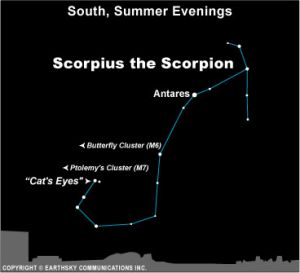Wow. Who knew a supermoon could be so exciting? Thanks for everyone who posted their great images from around the world on EarthSky’s Facebook page, and for all your wonderful comments and observations. Tonight’s moon – May 6, 2012 – will still look full, but it’s really a waning gibbous moon that lights the sky. You’ll find tonight’s moon near a bright star, red Antares in the constellation Scorpius, sometimes called the Heart of the Scorpion.
What time will the waning moon rise? The exact time depends on your location on the globe, and you can find some recommendations for sky almanacs here. For most of us, though, the moon will rise tonight as darkness is falling across your part of Earth. If your horizon is cluttered with trees, buildings or other obstacles, you’ll have to wait a few to several hours after sunset for the brilliant moon to rise higher in the sky.
Once you have the moon well in sight, say around 10 to 11 p.m. this evening (your local time), look below it for a nearby bright star. Tonight the moon appears on the sky’s dome near bright Antares, the ruddy Heart of the constellation Scorpius the Scorpion. Antares is a red supergiant star. It’s red because its outer layers are cool – at least cooler in contrast to other stars. Although it appears as a mere pinpoint of light in our night sky, Antares is so large that if it were to take the place of our sun, its outer layers would extend beyond the orbit of Mars.
By summer, Antares will be prominently placed in the early evening sky. If you have a darker sky, with no moon, you'll easily see its constellation, which features a pattern reminiscent of a real scorpion's curved tail.
Antares’ red color might be hard to discern on May 6, 2012 next to the spotlight of the big and brilliant moon. So note this star’s location tonight in the east in the evening. And notice the pattern of stars around it. Then come back to this star when the moon has moved away, and you’ll clearly see how red it is – and how fiercely it twinkles when it’s low in the sky.
Antares is known for twinkling madly and displaying glints of other colors. When a star lies low in the sky, we see it through much more air than when the star is closer to overhead. Earth’s atmosphere is what causes stars to twinkle, so stars seen low in the sky – like Antares in the evening now – twinkle more fiercely.
Bottom line: Use the moon to find Antares, the Heart of the Scorpion in the constellation Scorpius, on May 6, 2012. After the excitement over last night’s full supermoon, the moon is now waning. But it’ll still look round and full in your night sky, and it’ll be beautiful near this star.



No comments:
Post a Comment